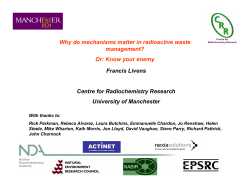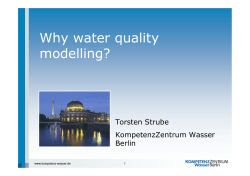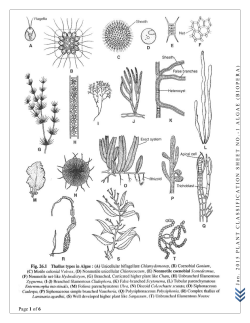
To: SAMPLE(s): “Lake #6” Received:
Date: To: Attn: SAMPLE(s): “Lake #6” Received: Analyzed: Sample analyzed by Benjamin Pankratz and Deborah Lee, Microbiologist, AQUAFIX Problem(s): Perform water quality analysis and identify algae and/or plants. Microscopic Observation Sample “Lake #6” Algae taken off plants in sample Water Quality Analysis Sample “Lake #6” Sample filtered though 0.45um pore membrane Wet mount unstained viewed under 400X magnification A B C Lake #6 Conductivity 553.3 uS Salinity (NaCl) 0.249 ‰ Total Dissolved Solids 378.9 ppm Oxidation Reduction Potential 195 mV pH @ 18.0C 8.25 NH3 0.0 ppm NO2- 0.001 ppm NO3- 0.0 ppm PO43- 0.01 ppm Total Iron (undigested sample) 0.05 ppm SiO2 0.082 ppm Total Hardness 280 ppm as CaCO3 Calcium Hardness 210 ppm as CaCO3 Magnesium Hardness 70 ppm as CaCO3 Total Alkalinity 220 ppm as CaCO3 Phenolphthalein Alkalinity 0.0 ppm as CaCO3 Summary One bottle of algae contained filamentous green algae similar to Hydrodictyon along with strands of Oedogonium and low amounts of the filamentous cyanobacterium Scytonema. The Hydrodictyon in the sample appeared damaged but this could have been due to where it was collected from. There were healthy microcolonies present in the sample. o Hydrodictyon, commonly called “water net”, is a colonial planktonic green alga that forms floating mats. The cells are cylindrical and once cell is attached to two others at the ends forming a large reticulate network. Each cell can produce a cylindrical net within it which can rapidly expand upon release. This alga is commonly found in eutrophic hard water environments where it can rapidly cover the surface of a pond. o Oedogonium is green alga that forms unbranched, uniseriated filaments composed of long cylindrical cells. The cells are highly vacuolated with large reticulate, parietal chloroplast and usually many pyrenoids. Some species have a long spike on the terminal cell called a clyptra. This alga does have a thin mucilaginous coating but is generally not slimy to the touch. A definitive characteristic of this alga is the presence of rings or bands at the anterior end of vegetative cells that are formed during vegetative cell division and are the remnants of broken parietal cell walls. This alga can reproduce both asexually by fragmentation or zoospore production and also sexually resulting in the formation of oospores that are brown or red in color. Oedogonium is generally found attached to submersed plants or organic debris via a basal holdfast cell although some species are known to create floating mats. Most species are found in stagnant, slow-moving water, possibly containing high nitrates. The other bottle of algae consisted of a mat and plant fragments. The algae mats appeared to be mostly Lyngbya and Scytonema, filamentous cyanobacteria, and low amounts of filamentous green algae that were too fragmented to identify. Some of the plant fragments were similar to the alga Chara. o Lyngbya is a filamentous cyanobacterium that forms layered, leathery, dark colored mats that rise to the surface of ponds and lakes. These filaments are straight and uniseriated without heterocytes or akinetes and are generally very thick, greater than 5.5um wide. Rarely, the filaments display false branching. The cells are discoid and usually much wider than long and are blue-green, olive-green, yellowish, or brownish in color with many fine granules. The trichomes are generally encased in firm sheaths that are sometimes multi-layered and may be brownish in color and open at the ends of the filament. Under extreme conditions, the trichomes may leave the sheaths. Reproduction is by asexual cell division or by production of hormogonia, short motile filaments that are ejected from the sheaths and can form full filaments at a different location. Lyngbya is very similar in appearance to Phormidium, which has a thinner sticky sheath, and Oscillatoria, which normally lacks a sheath and has tapering apical cells. Lyngbya is generally found in areas of calm clear water with high light intensity and sandy bottoms in fresh or brackish water. o Scytonema is a filamentous cyanobacterium that forms dark mats on substrates that float to the surface of ponds and lakes. The filaments are uniseriated with solitary intercalary heterocytes. Heterocytes are specialized structures where nitrogen fixation, converting atmospheric dinitrogen to ammonium and/or glutamine, takes place. The vegetative cells in the filament are pale green or olive-green, with granular content, cylindrical or barrel-shaped. There is usually a sheath present that may be thin and narrow or wide and lamellate and is often yellow or brown in color due to the presence of scytonemin. Scytonema reproduces by asexual cell division as well as by hormogonia, which are liberated from the sheath. This cyanobacterium commonly displays false branching with the two branches extending from a break in the trichome of one filament and growing parallel to one another. Branching does not usually occur at heterocytes, as in Tolypothrix. Nodularia is similar in appearance but does not exhibit false or true branching. Many species of Scytonema are found growing in alkali fresh waters with high incoming phosphorus levels. This alga commonly grows on rocks, wood, or soil and some species have sheaths that are incrusted by calcium carbonate. o Chara is a macrophytic alga that looks like a simple vascular plant. Some common names include muskgrass, skunkweed, and stonewort. This alga typically grows to 10-50cm high with a “stem” that is 0.5-1.0mm in diameter. It typically appears gray or dark green and may feel gritty and smell musty when crushed. Although as an alga it has no true roots it can attach to bottom substrates by holdfast cells. The “stem” bears whorls of branchlets, between 6-16, that are cylindrical and clustered at regularly spaced nodes. These branchlets are never divided and are of equal length often with tiny thorn-like projections at the ends. The gritty feeling of this alga is due to build ups of calcium deposits on the surface of the algal cells. Chara reproduces vegetatively by fragmentation or sexually. The plants can be monoecius or dioecious and the oogonium is 900um long, brown or black, with five cells wrapped around in a spiral to form the coronula. The antheridium is up to 500um in diameter. Chara is generally found in freshwater, both soft and alkaline, and grows down to 1m in a variety of ponds, rivers, littoral pools, or slowly flowing streams. This genus of algae is highly polymorphic and many forms have been described. Nitella is similar in appearance to Chara but has symmetrically forked smooth branchlets and does not have the calcium coating or musty odor. Tolypella spp. have unsymmetrically forked branchlets. Chara may sometimes be confused with some vascular plants such as Najas flexilus and Ceratophyllum demersum, which also do not produce an odor when crushed. Raking is not an effective control of Chara as fragments can give rise to new plants. The water sample contained low nitrogen, with enough orthophosphate for blue greens algae to bloom, especially since Scytonema can fix nitrogen. The water was hard with high alkalinity. It is possible that the nutrient levels in the water were higher before but the plants and algae present in the lake used all of the nutrients. The nutrients could have also been used by bacteria in the water sample during transit. It could be that most nutrients may be concentrating close to the shoreline of the lake. Recommend Control of the various algae will depend on the location and prevalence of each type. In the mat sample, there seems to be more biomass of Lyngbya and Scytonema mixed in with fragments of plants. Perhaps this mat is occurring in the littoral zone? It is not clear if the algae that contained Hydrodictyon are in a different area from where the mat-formers were sampled or if it was floating on top of the same area. Generally, we recommend mixing AquaSticker with Hydrothol 191, the preferred algaecide for controling Lyngbya and Scytonema. Spraying PondZilla 100 may help to quickly degrading the resulting dead, decaying biomass and remove the resulting nutrients from the water column. It is possible that Hydrothol 191 will also be able to control Hydrodictyon, however we generally recommend nutrient removal instead though applications of VitaStim MD Pellets and VitaStim Summer Slam or VitaStim 6000. Diquat is recommended to control Chara, but not to be used in water with high levels of suspended sediments. Visit us on the web! http://www.naturalake.com
© Copyright 2025















